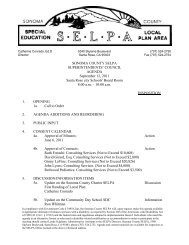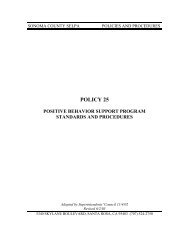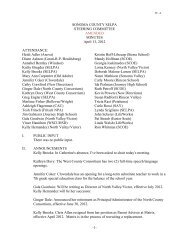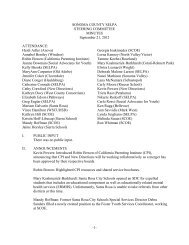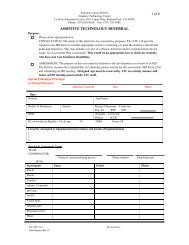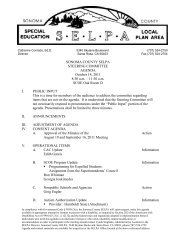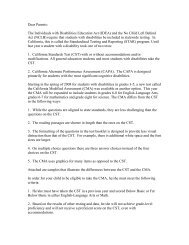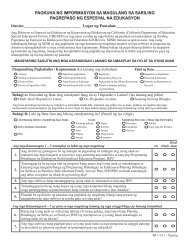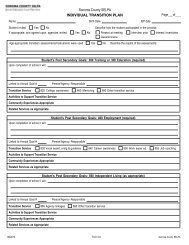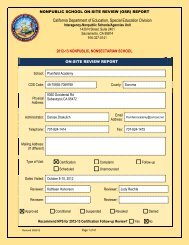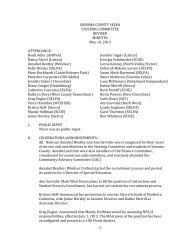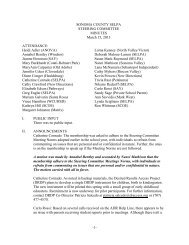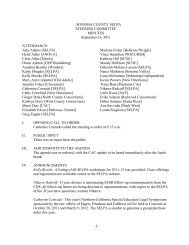Services for Students with Emotional and Behavioral Difficulties 6/12
Services for Students with Emotional and Behavioral Difficulties 6/12
Services for Students with Emotional and Behavioral Difficulties 6/12
You also want an ePaper? Increase the reach of your titles
YUMPU automatically turns print PDFs into web optimized ePapers that Google loves.
S O N O M A<br />
C O U N T Y<br />
S E L P A<br />
Special Education Local Plan Area<br />
<strong>Services</strong> <strong>for</strong> <strong>Students</strong><br />
<strong>with</strong> <strong>Emotional</strong> <strong>and</strong> <strong>Behavioral</strong><br />
<strong>Difficulties</strong><br />
■<br />
June 20<strong>12</strong><br />
S o n o m a County SELPA<br />
5340 Skylane Boulevard<br />
Santa Rosa, Cali<strong>for</strong>nia 95403<br />
(707) 524-2750<br />
26
Introduction<br />
Sonoma County’s local education agencies, in collaboration <strong>with</strong> the Sonoma County<br />
Mental Health department, nonpublic schools, <strong>and</strong> nonpublic agencies, provide a<br />
variety of services to students <strong>with</strong> disabilities who exhibit emotional <strong>and</strong> behavioral<br />
difficulties. The goal of the Sonoma County Special Education Local Plan Area<br />
(SELPA) is to ensure the availability of a continuum of options so that these students<br />
may access an appropriate level of service.<br />
One of the major principles of the Individuals <strong>with</strong> Disabilities Education Act (IDEA)<br />
is to educate students <strong>with</strong> disabilities in the least restrictive environment. The<br />
Sonoma County SELPA’s goal is <strong>for</strong> students <strong>with</strong> disabilities to have the opportunity,<br />
whenever possible, to attend the same public school as non-disabled students as close<br />
to home as possible, unless it is determined by an IEP team that the students require<br />
alternative programs to meet their educational <strong>and</strong> social needs.<br />
This document describes the variety of placement <strong>and</strong> service options available in<br />
Sonoma County <strong>for</strong> students <strong>with</strong> emotional <strong>and</strong> behavioral difficulties.<br />
n SELPA’s Positive Behavior Support (PBS) Program utilizes behavior<br />
specialists <strong>and</strong> the development of positive behavior intervention plans at the<br />
local school level to manage behaviors in the least restrictive environment. For<br />
in<strong>for</strong>mation regarding the PBS program, see pages 2-4 or contact the SELPA<br />
office at (707) 524-2752.<br />
n The programs <strong>and</strong> services offered by the Sonoma County Office of<br />
Education (SCOE) are described on pages 5-13. For further in<strong>for</strong>mation<br />
regarding the SCOE/TREC Program, contact SCOE special education<br />
principal Melinda Susan at (707) 524-2868.<br />
n The services offered by the nonpublic schools (NPS) in Sonoma County<br />
are <strong>for</strong> those students who are unable to have their needs met <strong>with</strong>in the<br />
local public schools <strong>and</strong>/or Sonoma County Office of Education program.<br />
For in<strong>for</strong>mation regarding the NPS programs see pages 14-25 or contact<br />
the SELPA office, (707) 524-2752.<br />
1
Positive Behavior Support (PBS) Program<br />
Coordinated by the Sonoma County SELPA<br />
The Sonoma County SELPA established the Positive Behavior Support Program to assist<br />
districts in developing effective long-term interventions <strong>for</strong> special education students <strong>with</strong><br />
challenging behaviors.<br />
Part of the impetus <strong>for</strong> this program came from a realization that many children were being<br />
assigned Temporary Support Assistants (<strong>for</strong>merly known as 1:1 assistants) to allow them<br />
access to the curriculum. The growing number of these assistants was translating into rising<br />
costs, but the available reimbursement was not similarly increasing. In addition, recent<br />
research demonstrates—<strong>and</strong> consensus in the field of special education <strong>and</strong> behavior analysis<br />
concurs—that the use of Temporary Support Assistants can actually be detrimental to a<br />
student’s independence <strong>and</strong> ultimate success in school. Given these findings, the Sonoma<br />
County SELPA decided to help local districts develop the skills to support children <strong>with</strong><br />
challenging behaviors, while reducing or eliminating the need <strong>for</strong> Temporary Support<br />
Assistants.<br />
Scope of the Program<br />
The program has two main components:<br />
n Utilizing behavior specialists to support identified children <strong>and</strong> their families.<br />
n Providing comprehensive staff development by the Sonoma County SELPA in<br />
response to the needs of district staff.<br />
Behavior Specialists<br />
For the 2011-<strong>12</strong> school year, the SELPA has four behavior specialists assigned to districts<br />
around the county. Another eight district-employed behavior specialists make up the cadre<br />
of specialists serving all school districts in the county. Partial reimbursement to districts is<br />
provided to enhance continued district support. Behavior specialists are responsible <strong>for</strong> the<br />
following services, in collaboration <strong>with</strong> district staff:<br />
n IEP-Driven Consultation <strong>Services</strong>: Upon referral from the district, these services<br />
may include observation of the student, functional behavioral assessment<br />
2
(descriptive analysis), data collection, interviews <strong>with</strong> staff <strong>and</strong> parents, <strong>and</strong> written<br />
recommendations. The intent of this process is that the IEP team review how the<br />
student has been supported to date, prior to referring that student <strong>for</strong> specialist<br />
services.<br />
n Collaborative Development of Behavior Support Plan (BSP): The IEP team, acting in<br />
consultation <strong>with</strong> a behavior specialist, may determine that a Behavior Support Plan<br />
should be developed. The plan is developed collaboratively by the classroom teacher,<br />
district psychologist, <strong>and</strong> any other adults who are familiar <strong>with</strong> the student (such as<br />
a parent or administrator). The intent of collaborative development of the plan is to<br />
increase buy-in <strong>for</strong> its implementation.<br />
n Collaborative Functional Analysis Assessment (FAA) <strong>and</strong> Development of the Behavior<br />
Intervention Plan (BIP): For Hughes Bill-driven FAAs, the behavior specialist may<br />
conduct all of the prescribed components of the analysis in collaboration <strong>with</strong> district<br />
staff, again including the teacher, psychologist, parent, <strong>and</strong> other staff as appropriate.<br />
n Local Staff Development: The school or district may identify specific staff development<br />
needs <strong>for</strong> the behavior specialist to address. The intention is to use the specialist to<br />
build the school’s capacity to support positive behavior through implementation<br />
of best practices. Staff development options are based on the SELPA-wide options<br />
detailed below.<br />
SELPA-wide Staff Development Options<br />
The Sonoma County SELPA will provide staff development to facilitate support of positive<br />
behavior. These trainings are <strong>for</strong> school teams <strong>and</strong> may include the following:<br />
n School-Wide Effective <strong>Behavioral</strong> Support Training: This type of training focuses on<br />
developing a school’s capacity to assess its site <strong>for</strong> appropriate practices; determine<br />
rules; <strong>and</strong> develop methods of acknowledging positive behavior, correcting behavioral<br />
mistakes, <strong>and</strong> developing effective school-wide, classroom, <strong>and</strong> individual support<br />
strategies. An example of this kind of training is the Building Effective Schools<br />
Together (BEST) program from the University of Oregon’s Institute on Violence <strong>and</strong><br />
Destructive Behavior.<br />
n Behavior Support Plan (BSP) Development: This training is provided by the Sonoma<br />
County SELPA or by Diana Browning Wright or a similar independent presenter.<br />
The focus is on building staff capacity to develop effective Behavior Support Plans.<br />
Participants learn how to develop a 1-2 page plan that meets IDEA requirements.<br />
3
n Behavior Intervention Teams (BIT) Training: This training is provided by the Sonoma<br />
County SELPA <strong>and</strong> focuses on enhancing a school team’s capacity to develop effective<br />
individual Behavior Support Plans (BSP) <strong>for</strong> children <strong>with</strong> challenging behaviors.<br />
Teams learn how to conduct functional behavioral assessments <strong>and</strong> develop plans<br />
using a student study team model.<br />
n Individual School Team Training: The SELPA program specialist provides training <strong>for</strong><br />
staff at individual schools to address needs unique to those schools.<br />
n Effective Classroom Management: The Sonoma County SELPA provides training in<br />
research-based <strong>and</strong> validated classroom techniques <strong>and</strong> strategies. Trainings are geared<br />
toward classroom teachers <strong>and</strong> administrators.<br />
Referral Process<br />
Referral <strong>for</strong>ms are completed by district administrators <strong>and</strong> reviewed by the SELPA<br />
administrator or the special education coordinator of the district that employs the behavior<br />
specialist. If the <strong>for</strong>m is complete, the case is assigned to a behavior specialist.<br />
Program Future<br />
The SELPA Superintendents’ Council authorized the funding of the Positive Behavior<br />
Support Program in 2002 <strong>and</strong> has reauthorized it each year since. The future of the program<br />
will be contingent on a positive evaluation <strong>and</strong> securing long-term funding support. For<br />
more in<strong>for</strong>mation about the Positive Behavior Support Program, please contact the SELPA<br />
office at (707) 524-2752.<br />
4
The SCOE/TREC Program<br />
TREC: Teaching Responsibility, Educating, Counseling<br />
The Sonoma County Office of Education (SCOE) has developed the SCOE/TREC<br />
Program to meet the unique needs of students between the ages of 5 <strong>and</strong> 22 who exhibit<br />
emotional <strong>and</strong> behavioral challenges. The program is dedicated to helping these students<br />
manage significant emotional reactions, learn to behave responsibly, increase positive social<br />
interactions, increase resilience, <strong>and</strong> improve academic progress.<br />
The program consists of a continuum of special education classes designed to give students<br />
access to the core curriculum in a setting that also allows them to benefit from individual <strong>and</strong><br />
small group counseling <strong>and</strong> social skills training. Education-related mental health services<br />
are also infused throughout the school day. The classes are located on local school campuses<br />
<strong>and</strong> mental health services are provided by SCOE/TREC counselors. These counselors have<br />
master’s degrees in school psychology or other related fields (e.g., social work, marriage<br />
family counseling) <strong>and</strong> hold pupil personnel services (PPS) credentials issued by the<br />
Cali<strong>for</strong>nia Department of Education.<br />
Two key premises have guided the development of the program:<br />
Academic <strong>and</strong> behavioral success are linked. Once a student begins to experience<br />
behavioral or academic success, a path is cleared <strong>for</strong> improved functioning.<br />
Troubled children can be helped through a strategy of positive behavior support,<br />
which preserves students’ dignity <strong>and</strong> provides them <strong>with</strong> a sense of hope.<br />
Two additional values are integrated in the program:<br />
Respect <strong>for</strong> children. Being positive toward children <strong>and</strong> treating them <strong>with</strong> dignity<br />
is a core value of the program.<br />
Staffing by skilled <strong>and</strong> experienced professionals. Skilled <strong>and</strong> experienced professionals<br />
are essential to meeting students’ special needs. To be effective, staff must be able to<br />
support positive student behavior, facilitate inclusion, <strong>and</strong> demonstrate commitment<br />
to lifelong learning.<br />
Program Description<br />
The SCOE/TREC Program uses all available skills <strong>and</strong> resources to create an educational <strong>and</strong><br />
therapeutic community that provides a structured, nurturing environment <strong>for</strong> students <strong>and</strong><br />
develops their self-esteem. In this program:<br />
5
n Describing <strong>and</strong> reshaping the observable behaviors of students is the programmatic<br />
focus.<br />
n <strong>Students</strong> are taught to manage anger in appropriate ways <strong>and</strong> learn new ways of<br />
responding, thus clearing the way <strong>for</strong> improved academic learning.<br />
n Interventions that emphasize self-monitoring, self-control, <strong>and</strong> self-management<br />
strategies are combined <strong>with</strong> instruction that teaches social norms <strong>and</strong> expectations<br />
<strong>for</strong> classroom behavior.<br />
n Teachers continuously role-model appropriate ways to deal <strong>with</strong> feelings <strong>with</strong>in the<br />
classroom.<br />
n Parents are an extremely important part of the team <strong>and</strong> parental support of students<br />
<strong>and</strong> of program guidelines is crucial.<br />
n Individual educational programs are developed to promote students’ social<br />
development <strong>and</strong> academic success.<br />
n <strong>Students</strong> learn beneficial <strong>and</strong> socially appropriate ways to manage their emotions.<br />
n <strong>Students</strong> are referred <strong>and</strong> transitioned to less restrictive educational placements<br />
through successful completion of the program.<br />
n <strong>Students</strong> may be referred <strong>and</strong> transitioned to settings <strong>with</strong> more intensive <strong>and</strong><br />
comprehensive services if the program fails to meet the students’ emotional or<br />
behavioral needs.<br />
Classes in the SCOE/TREC Program are small—typically about ten students. The program<br />
relies on the collaborative interaction of participating agencies <strong>and</strong> combined staffing that<br />
includes credentialed special education teachers, special education teaching assistants,<br />
counselors, school nurse, school psychologist, <strong>and</strong> program administrator. <strong>Services</strong> provided<br />
include:<br />
Student counseling: Individual <strong>and</strong> group counseling, education-related counseling,<br />
class meetings, social skills instruction, <strong>and</strong> crisis management.<br />
Support services: School support/consultation, program evaluation, psychoeducational<br />
assessment, <strong>and</strong> positive behavior support.<br />
Assessment: Social-emotional evaluation, academic monitoring, <strong>and</strong> monitoring of<br />
ability to progress <strong>with</strong>in a structured environment.<br />
6
The academic program: Behavior <strong>and</strong> academic competence are concurrent, but separate,<br />
goals in the SCOE/TREC Program. The academic environment naturally creates situations<br />
where students are taught positive behaviors as they learn to listen to the teacher <strong>and</strong> ask<br />
questions using appropriate language <strong>and</strong> actions.<br />
n Learning takes place in com<strong>for</strong>table <strong>and</strong> attractive physical environments, in an<br />
atmosphere of support <strong>and</strong> respect where each student’s abilities are affirmed <strong>and</strong><br />
valued.<br />
n <strong>Students</strong> in the high school program earn credits that are applied toward a diploma<br />
or certificate of completion. Graduation requirements are aligned <strong>with</strong> the student’s<br />
school of residence rather than school of attendance (unless they are one <strong>and</strong> the<br />
same).<br />
n Mistakes are analyzed constructively <strong>and</strong> viewed as natural steps in the acquisition<br />
of knowledge <strong>and</strong> underst<strong>and</strong>ing.<br />
n Instruction is individualized. <strong>Students</strong> <strong>and</strong> teachers set learning goals that are<br />
realistic, but also challenging, attainable, pertinent to students’ future aspirations,<br />
<strong>and</strong> aligned <strong>with</strong> state st<strong>and</strong>ards.<br />
n Learning is connected to the real world <strong>and</strong> students learn how to apply what they<br />
learn to their lives <strong>and</strong> their communities.<br />
n Learning is an interactive process that models <strong>and</strong> supports the values of<br />
responsibility, honesty, personal choice, <strong>and</strong> self-direction.<br />
n Learning is diagnostic <strong>and</strong> reflective. The academic program is designed to<br />
provide continuous feedback to students <strong>and</strong> parents. Assessments are used as a tool<br />
to further teaching <strong>and</strong> learning. <strong>Students</strong> participate in state assessments, as well as<br />
individually administered st<strong>and</strong>ardized testing.<br />
Education-related mental health services: Counseling services are provided in the<br />
classroom <strong>and</strong> are individualized to meet each student’s needs. These services focus on<br />
interventions that enable the child to benefit from special education, help children <strong>and</strong><br />
families underst<strong>and</strong> how feelings can trigger behaviors, <strong>and</strong> enable students to discover new<br />
ways of managing feelings <strong>and</strong> resulting behaviors. The counseling services are structured to<br />
meet the emotional needs of the child <strong>and</strong> work in partnership <strong>with</strong> the behavior program<br />
or individual behavior support plan. Counselors, parents, <strong>and</strong> students cooperatively develop<br />
measurable counseling goals <strong>and</strong> objectives.<br />
7
Positive behavior support: The program’s positive behavior support system is based<br />
on the goal of teaching students to become contributing members of their communities.<br />
<strong>Students</strong> are encouraged through verbal rein<strong>for</strong>cement, tokens, points, <strong>and</strong> creative methods<br />
of individualizing rewards <strong>and</strong> interventions so that they are motivating to students. As<br />
students move through the system, they acquire more freedoms <strong>and</strong> more responsibilities.<br />
Behavior support follows a level or step system. Each step has its own criteria <strong>and</strong> goals. This<br />
system, along <strong>with</strong> general rules <strong>and</strong> norms, is the basis <strong>for</strong> the classroom’s social contract.<br />
The social contract is an agreement on the code of conduct <strong>for</strong> class <strong>and</strong> explains how the<br />
class, as a whole, operates.<br />
Daily communication regarding students’ positive behavior enables students <strong>and</strong> families<br />
to internalize new <strong>and</strong> positive ways of interacting. Each day, students are provided <strong>with</strong><br />
point sheets that allow parents to review behaviors during the day. The ultimate goal is<br />
to successfully return students to less restrictive placements, <strong>with</strong> a transition plan <strong>and</strong><br />
appropriate supports in place so they can continue to be successful.<br />
The primary program does not use a leveled system, the elementary classes have three levels,<br />
<strong>and</strong> the middle school <strong>and</strong> high school programs have five levels. The levels range from the<br />
most supportive at Level 1 <strong>and</strong> progress as the student learns to manage his/her behavior to<br />
Level 3 (elementary school) or Level 5 (middle <strong>and</strong> high school). At each level, students are<br />
expected to maintain behaviors at the previous level while meeting expectations at the new<br />
level. As students progress on the level system, they acquire increased opportunities.<br />
The level system provides a way to monitor student behavior <strong>and</strong> ensure that teachers<br />
maintain educational <strong>and</strong> instructional control <strong>with</strong> the student. Additionally, the levels are<br />
based on behaviors that build toward a “successful independent student.”<br />
Level 1: Working on boundaries<br />
Level 2: Learning self-regulation <strong>and</strong> compliance<br />
Level 3: Being a team player<br />
Level 4: Becoming self-managers<br />
Level 5: Acting as successful, independent students<br />
Each student participates in a self-monitoring activity at the end of each work period. They<br />
record their behaviors (e.g., asked <strong>for</strong> help during lesson), while staff complete a similar<br />
monitoring <strong>for</strong>m to verify the accuracy of the student’s reporting. Comparison of the two<br />
ratings is the basis <strong>for</strong> promotion to the next level.<br />
<strong>Students</strong> are consistently rein<strong>for</strong>ced throughout the school day. In addition to the level<br />
system, teachers incorporate at least two other positive rein<strong>for</strong>cement techniques into each<br />
day’s program (e.g., mystery motivators, raffles, tickets to buy store items, etc.).<br />
8
Behavior support plans: If a student has a behavior support plan or behavior<br />
intervention plan in place prior to entering the SCOE/TREC Program, it will be reviewed<br />
<strong>and</strong> revised <strong>for</strong> the new setting. Typically, recommendations from a behavior support<br />
plan generated when the student is in a general education setting are consistent <strong>with</strong><br />
programmatic behavior support (general discipline plan) <strong>with</strong>in the SCOE/TREC classrooms.<br />
Individual behavior support plans <strong>and</strong> behavior goals are also developed <strong>with</strong>in the program<br />
when students are not progressing as a result of the classroom positive behavior support<br />
system or in the case of repeated occurrences of the targeted behavior.<br />
The behavior support plan is developed collaboratively <strong>with</strong> the classroom teacher, parent,<br />
school psychologist, classroom psychologist, <strong>and</strong> student, when appropriate.<br />
Examples of level privileges *<br />
n Level 1: Student has access to some, but not all, areas of the campus <strong>and</strong><br />
is supervised at all times.<br />
n Level 2: Student has access to activities <strong>with</strong>in the room <strong>and</strong> more<br />
access to free-time activities <strong>and</strong> social opportunities <strong>with</strong> peers.<br />
n Level 3: Student has access to classes in the regular education setting.<br />
n Level 4: Student has more integration opportunities.<br />
n Level 5: Student is no longer on the point or level system.<br />
* Note that a student’s level is not the only factor in determining<br />
if a student will integrate into a general education class.<br />
Integration: One of the goals of the SCOE/TREC Program is to provide students <strong>with</strong> the<br />
resources <strong>and</strong> skills to successfully function in the general education setting. Teachers in the<br />
SCOE/TREC Program provide students <strong>with</strong> as many opportunities as possible to integrate<br />
on the general education campus. These integration opportunities may include lunch, recess,<br />
campus activities, <strong>and</strong> academic classes. <strong>Students</strong> are often referred to Special Day Class<br />
(SDC) classrooms because they have significant emotional <strong>and</strong> behavioral reactions that have<br />
impacted their ability to access curriculum in the general education setting.<br />
A student’s level is not the only factor in determining if a student will integrate into a<br />
general education class. Other factors may include student interest, emotional state (e.g.,<br />
student <strong>with</strong> severe anxiety may choose to stay in the SDC), IEP team recommendations<br />
(which include parent input), individual goals <strong>and</strong> objectives, behavior support plan<br />
recommendations, <strong>and</strong> class availability. Typically, students need to progress on the classroom<br />
level system prior to integration to ensure that they will be able to maintain appropriate<br />
9
ehaviors in that setting (e.g., maintaining focus, positive peer interactions, asking <strong>for</strong> help).<br />
It is not untypical <strong>for</strong> students in SCOE/TREC classes to move in both directions on the<br />
level system. This happens <strong>for</strong> a variety of reasons. While certain privileges are retracted <strong>with</strong><br />
a level drop, the opportunity to keep attending general education classes is not necessarily<br />
retracted. In most cases, students continue to attend their general education classes as<br />
attendance in these classes fosters self-esteem <strong>and</strong> helps build resilience in students.<br />
General discipline plan: The discipline plan is in place <strong>for</strong> those times when students<br />
are struggling <strong>and</strong> unable to follow the social contract of the classroom. The plan has three<br />
dimensions: prevention, action, <strong>and</strong> resolution.<br />
n Prevention: Positive engagement <strong>with</strong> staff, peers, <strong>and</strong> curriculum is motivating <strong>and</strong><br />
becomes the basis <strong>for</strong> a new social contract, class rules, <strong>and</strong> consequences. Rules are<br />
designed <strong>and</strong> taught to help meet the needs of the entire class. Classrooms include<br />
a basic set of rules that are posted <strong>and</strong> used consistently throughout all classrooms,<br />
elementary to high school. These rules are based on the Building Effective Schools<br />
Together (BEST) protocol: Follow directions the first time, Be respectful, Be responsible,<br />
Be safe, <strong>and</strong> Encourage others.<br />
Teachers appropriately en<strong>for</strong>ce the rules <strong>and</strong> implement consequences when rules<br />
are broken, although specific consequences are not generally tied to rule violations.<br />
Teachers have the flexibility to apply individualized consequences to particular<br />
students under a philosophy that “fair is not always equal.” <strong>Students</strong> behave <strong>and</strong> react<br />
differently, so they are treated differently.<br />
Consequences are not viewed as punishments, but are logical <strong>and</strong> usually involve<br />
doing correctly what was done wrong. <strong>Students</strong> are given an accurate, clearly<br />
stated, <strong>and</strong> specific description of what is likely to happen when a rule is broken.<br />
This preserves student dignity <strong>and</strong> allows students to make responsible decisions.<br />
Consequences may include “chills,” time out (which may include brief removal from<br />
the classroom <strong>for</strong> an extended time out), in-school supervision, <strong>and</strong> home suspension.<br />
The social contract <strong>and</strong> classroom norms are taught regularly <strong>and</strong> teachers measure<br />
student underst<strong>and</strong>ing. The expectation is that students <strong>and</strong> staff underst<strong>and</strong> the<br />
rules, which are embedded into the program <strong>and</strong> continuously discussed, modeled,<br />
<strong>and</strong> rein<strong>for</strong>ced.<br />
n Action: Teachers positively praise <strong>and</strong> rein<strong>for</strong>ce appropriate social interactions.<br />
When a rule is broken, the teacher appropriately en<strong>for</strong>ces rules <strong>and</strong> implements<br />
consequences. This is not an automatic response, but an opportunity to interact<br />
10
<strong>with</strong> students productively <strong>and</strong> create a teachable moment. The method of<br />
implementation is as important as the consequence.<br />
n Resolution: This is the time to <strong>for</strong>mulate positive action plans <strong>for</strong> students’ behavior.<br />
During this interaction, teachers assess the situation to determine the function of<br />
the students’ behavior, find out what is needed to prevent reoccurrence, work out a<br />
mutually agreeable plan, implement <strong>and</strong> monitor the plan, use creative approaches<br />
to implement the plan successfully, <strong>and</strong> access therapeutic supports <strong>and</strong> services. A<br />
SELPA Positive Behavior Support Plan is developed in cases of repeated incidents.<br />
Referral procedures: <strong>Students</strong> are referred to the SCOE/TREC Program by their district<br />
of residence. Once referral <strong>for</strong>ms are received from the district, the school psychologist or<br />
principal contacts the district representative to discuss the student’s educational needs.<br />
If it is determined that the student’s identified needs likely can be addressed in the SCOE/<br />
TREC program, a classroom visit is scheduled <strong>for</strong> the parents. The visit is followed by an<br />
IEP meeting attended by the student <strong>and</strong> his/her parents, SCOE administrator, <strong>and</strong> district<br />
representatives. Other participants may include the SCOE teacher, support agencies, <strong>and</strong>/or<br />
the student’s current classroom teacher. This IEP meeting is designed to discuss placement<br />
options <strong>and</strong> address all concerns. If the SCOE/TREC Program is the placement option<br />
chosen, a 30-day IEP review will be scheduled to determine that the setting is appropriate. If<br />
it is determined by the IEP team that the student requires a more restrictive setting, SCOE<br />
will support the district <strong>with</strong> in<strong>for</strong>mation about potential non-public school settings.<br />
For more in<strong>for</strong>mation about the SCOE/TREC Program, please contact:<br />
Special Education Department<br />
8511 Liman Way, Rohnert Park, CA 94928<br />
(707) 524-2868 n Fax (707) 524-2943<br />
Melinda Susan, Principal<br />
Tyson Dickinson, School Psychologist<br />
11
20<strong>12</strong>-13 Programs<br />
Staffing <strong>for</strong> the following programs includes one credentialed special education teacher <strong>and</strong><br />
two teaching assistants assigned to each classroom.<br />
n Olivet School, Positive <strong>Emotional</strong> <strong>Behavioral</strong> Learning Launch (PEBBL): Primary early<br />
intervention program (grades k-1) on a regular education campus in northwestern<br />
Santa Rosa. On-site therapist. <strong>Students</strong> range in age from 5 to 7 years, LD, SLI, <strong>and</strong><br />
ED. Capacity: 10 students.<br />
n Doyle Park School: Early elementary program (grades 2-3) on a regular education<br />
campus in Santa Rosa. On-site therapist. <strong>Students</strong> range in age from 7 to 9 years,<br />
ED <strong>and</strong> SLD. Capacity: 10 students.<br />
n Schaefer School: Secondary elementary program (grades 4-5) on a regular education<br />
campus in northwestern Santa Rosa. On-site therapist. <strong>Students</strong> range in age from<br />
9 to 11 years, ED <strong>and</strong> LD. Capacity: 10 students.<br />
n Waldo Rohnert School: Secondary elementary program (grades 4-5) on a regular<br />
education campus in Rohnert Park. On-site therapist. <strong>Students</strong> range in age from<br />
9 to 11 years, ED <strong>and</strong> LD. Capacity: 10 students.<br />
n Lawrence E. Jones Middle School: Middle school program serving grades 6-8 on a<br />
regular education campus in Rohnert Park. On-site therapist. <strong>Students</strong> range in age<br />
from 11 to 13 years, ED <strong>and</strong> LD. Capacity: 10-<strong>12</strong> students.<br />
n Windsor Middle School: Middle school program serving grades 6-8 on a regular<br />
education campus in Windsor. On-site therapist. <strong>Students</strong> range in age from 11 to 13<br />
years, ED <strong>and</strong> LD. Capacity: 10-<strong>12</strong> students.<br />
n Northwest Prep Bike Shop: Middle school program serving grades 6-8 on a regular<br />
education campus in northwestern Santa Rosa. <strong>Students</strong> spend part of their day<br />
in a school bike shop where they repair, restore, <strong>and</strong> build bikes. On site-therapist.<br />
<strong>Students</strong> range in age from 11-13 years, ED <strong>and</strong> LD. Capacity: 10 students.<br />
n Northwest Prep Bike Shop: High school program serving grades 9-<strong>12</strong> on a regular<br />
education campus in northwestern Santa Rosa. <strong>Students</strong> spend part of their day<br />
in a school bike shop where they repair, restore, <strong>and</strong> build bikes. On site-therapist.<br />
<strong>Students</strong> range in age from 14-18 years, ED <strong>and</strong> LD. Capacity: 10-<strong>12</strong> students.<br />
n Rancho Cotate High School: High school class on a regular education campus in<br />
Rohnert Park. On-site therapist. <strong>Students</strong> range in age from 14 to 18 years, ED <strong>and</strong><br />
LD. Capacity: 10-<strong>12</strong> students.<br />
<strong>12</strong>
Telephone Contacts<br />
n<br />
Sonoma County Office of Education (SCOE)<br />
Region 2 Special Education Office, (707) 524-2868<br />
Melinda Susan, principal<br />
Tyson Dickinson, school psychologist<br />
Donna Bley or Christy Mielock, school nurse<br />
Kimberly Gehl, office coordinator<br />
n Matrix Parent Network <strong>and</strong> Resource Center, (415) 475-2119<br />
n Cali<strong>for</strong>nia Parenting Institute, (707) 585-6108<br />
n North Bay Regional Center, (707) 569-2000<br />
13
Certified Nonpublic Schools<br />
serving ED/BD <strong>Students</strong><br />
Operating as of June 20<strong>12</strong><br />
Cali<strong>for</strong>nia State Department Nonpublic School Directory Disability Codes:<br />
AUT = Autistic<br />
HH = Hard of Hearing/Deaf<br />
MR = Mentally Retarded<br />
SLD = Specific Learning Disabled<br />
ED = <strong>Emotional</strong>ly Disturbed<br />
MH = Multiple H<strong>and</strong>icapped<br />
SI = Speech Impaired<br />
OHI = Other Health Impaired<br />
Note: All eligibilities are accepted, but may not be preferred by a particular nonpublic school<br />
(NPS). All nonpublic school programs will allow districts to contract <strong>for</strong> student-needed DIS<br />
services if the NPS does not have a provider. Most NPS programs will issue a private school<br />
high school diploma based on appropriate credits earned as required by the state.<br />
Anova Center <strong>for</strong> Education (ACE School)<br />
3033 Clevel<strong>and</strong> Avenue, Suite 240, Santa Rosa, CA 95403<br />
CDS Code: 49-709<strong>12</strong>-6130165<br />
Age Group: 5-22 Capacity: 84<br />
M/F: Both Grade Level: K-<strong>12</strong><br />
Residential: No, day students only<br />
Disabilities: AUT, SLD/BD, ED, OHI, MR, MH<br />
Contact: Andrew Bailey, abailey@anovaeducation.org, 527-7032, fax 527-7960<br />
Mailing Address: 2911 Clevel<strong>and</strong> Avenue, Santa Rosa, CA 95403<br />
<strong>Services</strong> Provided:<br />
Adapted Physical Education<br />
Behavior Intervention<br />
Speech <strong>and</strong> Language<br />
Occupational Therapy<br />
Psychological <strong>Services</strong><br />
Parent Counseling <strong>and</strong> Training<br />
Counseling <strong>and</strong> Guidance <strong>Services</strong><br />
Temporary support assistant as requested by IEP<br />
Program Description: The Anova Center <strong>for</strong> Education or ACE School serves children <strong>and</strong><br />
teens diagnosed <strong>with</strong> high functioning Autism, Asperger Syndrome, emotional problems,<br />
learning disabilities, <strong>and</strong> other neuro-cognitive impairments. <strong>Students</strong> experiencing academic,<br />
emotional, <strong>and</strong>/or behavioral challenges benefit from this school’s specialized learning<br />
environment, which addresses both academic <strong>and</strong> social issues related to their disabilities.<br />
14
The ACE School emphasizes academic instruction meeting Cali<strong>for</strong>nia state st<strong>and</strong>ards, <strong>with</strong><br />
an enhanced staff-to-student ratio <strong>and</strong> small class sizes (no more than <strong>12</strong> students per class).<br />
The school provides specialized treatment to address complex sensory integration difficulties,<br />
specific learning disabilities, language deficits, <strong>and</strong> impairments in social cognition <strong>and</strong><br />
related skills. Support services are available <strong>for</strong> ACE students during their school day. The<br />
use of adaptive technology (including multiple laptops per classroom <strong>and</strong> state-of-the-art<br />
educational software), video modeling, <strong>and</strong> other multi-sensory approaches are also an<br />
important part of our curriculum. ACE teachers, therapists, <strong>and</strong> support staff are dedicated to<br />
helping each student achieve academic competence, learn the interaction skills necessary to<br />
navigate the social world, <strong>and</strong> re-integrate to their neighborhood school <strong>with</strong> the skills<br />
<strong>and</strong> confidence necessary to function independently <strong>and</strong> maximize their success.<br />
Note: Some ACE School services are available to any community member affected by a<br />
disabling condition, including group <strong>and</strong> individual speech <strong>and</strong> occupational therapy<br />
services, social skills groups, <strong>and</strong> behavior intervention development/implementation.<br />
Cypress School<br />
3835 Cypress Drive, Suite 103, Petaluma, CA 94954<br />
CDS Code: 49-70862-0115493<br />
Age Group: 5-22 Capacity: 24<br />
M/F: Both<br />
Grade Level: K-<strong>12</strong>, plus transition<br />
Residential: No, day students only<br />
Disabilities: AUT, MR<br />
Contact: Laura Briggin, lbriggin@ucpnb.org, 766-9990, fax 559-2466<br />
<strong>Services</strong> Provided:<br />
Counseling <strong>and</strong> Guidance <strong>Services</strong> Speech <strong>and</strong> Language<br />
Occupational Therapy<br />
Parent Counseling <strong>and</strong> Training<br />
Positive Behavior Intervention Psychological <strong>Services</strong><br />
Transportation<br />
Orientation <strong>and</strong> Mobility<br />
Temporary support assistant as requested by IEP<br />
Vision <strong>Services</strong><br />
Program Description: Cypress School serves children <strong>and</strong> young adults diagnosed <strong>with</strong> autism<br />
<strong>and</strong> similar disabilities <strong>with</strong> intensive behavioral support needs. The school provides a 1:2<br />
staff-to-student ratio <strong>and</strong> small class sizes of <strong>12</strong> students. Building on individual learning<br />
strengths <strong>and</strong> utilizing best practice, multi-disciplinary, <strong>and</strong> evidence-based methods, the<br />
school provides students <strong>with</strong> assessments to determine learning style, IEP goals, <strong>and</strong> daily<br />
15
safety needs. Cypress School individualizes a functional academic educational program<br />
meeting Cali<strong>for</strong>nia state st<strong>and</strong>ards. The curriculum is designed to help build meaningful<br />
skills across a variety of situations <strong>and</strong> settings, both in the classrooms <strong>and</strong> the community.<br />
<strong>Students</strong> learn additional life skills, including self-help <strong>and</strong> community living, pre-vocational<br />
<strong>and</strong> vocational education, communication, physical education, art, music, movement,<br />
sensory <strong>and</strong> behavioral regulation, <strong>and</strong> social skills. For students 16 to 22 years old,<br />
community work is provided in grounds-keeping, gardening, kitchen preparation, janitorial<br />
services, <strong>and</strong> clerical services.<br />
Coordination between the multi-disciplinary team—classroom teacher, Designated<br />
Instructional Service (DIS) therapists, families, <strong>and</strong> after-school providers—is a key element<br />
of supporting students’ IEP progress throughout the regular <strong>and</strong> extended school year. DIS<br />
therapists use a direct individual, group service, <strong>and</strong> consultative approach in therapy rooms,<br />
classrooms, <strong>and</strong> the community. Transportation DIS services can be provided by Cypress<br />
School staff to continue positive behavior supports <strong>and</strong> rein<strong>for</strong>cement plans <strong>and</strong> provide <strong>for</strong><br />
optimum student safety. A 30-day extended school year program is available based on IEP<br />
needs. Transition services are provided to support student re-entry to public school <strong>and</strong>/or<br />
transition to adult services.<br />
Greenacre Homes, Inc.<br />
7590 Atkinson Road, Sebastopol, CA 95472; 829-1366, fax 823-5070<br />
CDS Code: 49-70938-6906002<br />
Age Group: 9-22 Capacity: 48<br />
M/F: M Grade Level: 4-<strong>12</strong><br />
Residential: Please call RCL: 10<br />
Disabilities: MR, SI, ED, SLD, AUT, MH, OHI<br />
Contact: Benjie Swenson-Aguirre,<br />
bsaguirre@greenacrehomes.org, 823-8722, fax 823-3730<br />
Mailing Address: 438 Eddie Lane, Sebastopol, CA 95472<br />
<strong>Services</strong> Provided:<br />
Speech <strong>and</strong> Language<br />
Transportation<br />
Vocational Training<br />
Individual Therapy & Group Counseling<br />
Behavior Intervention<br />
Occupational Therapy<br />
Temporary support assistant as requested by IEP<br />
Program Description: Since opening in September of 1974, Greenacre Homes has been<br />
dedicated to serving boys <strong>with</strong> special needs. It is a private non-profit Cali<strong>for</strong>nia corporation<br />
16
that operates five residential treatment programs <strong>and</strong> a special education school <strong>for</strong> 35<br />
boys. Its homes are licensed by the State Department of Social <strong>Services</strong> <strong>and</strong> vendorized<br />
by the North Bay Regional Center. The school is certified by the Cali<strong>for</strong>nia Department<br />
of Education. Greenacre Homes serves boys <strong>with</strong> developmental delays <strong>and</strong>/or emotional<br />
disturbances. These boys require secure <strong>and</strong> structured home <strong>and</strong> school settings to benefit<br />
from therapeutic treatment. The school accepts boys placed by Social <strong>Services</strong>, Mental<br />
Health, Regional Center, <strong>and</strong> Probation Departments. Greenacre Homes continues to learn<br />
new ways to provide a stable <strong>and</strong> nurturing environment to boys needing specialized services.<br />
The staff creates a therapeutic milieu focusing on relationships, development, <strong>and</strong> care. The<br />
school specializes in vocational training (five job sites in the community), mental health<br />
services (individual, group, <strong>and</strong> family counseling), <strong>and</strong> reintegration into public school<br />
settings. Greenacre accepts day students.<br />
The Greenhouse Academy<br />
1432 Peterson Lane, Santa Rosa, CA 95403<br />
CDS Code: 49-70920-6202634<br />
Age Group: 13-18 Capacity: 6<br />
M/F: M Grade Level: 7-<strong>12</strong><br />
Residential: Please call<br />
Disabilities: ED, SLD<br />
Contact: Aaron Browe, aaronbrowe@yahoo.com, 291-0469, fax 575-5543<br />
Mailing Address: P.O. Box 6322, Santa Rosa, CA 95403<br />
<strong>Services</strong> Provided:<br />
Transportation<br />
Family Therapy<br />
Behavior Intervention<br />
Individual Therapy<br />
Group Therapy<br />
Vocational Education<br />
Temporary support assistant as requested by IEP<br />
Program Description: The Greenhouse Academy provides residential treatment <strong>for</strong> seriously<br />
emotionally disturbed adolescents. Greenhouse also provides a non-public school <strong>for</strong> the<br />
residents placed <strong>with</strong> our program. Greenhouse Academy is staffed by a special education<br />
credentialed teacher <strong>and</strong> experienced instructional aides. After careful assessment,<br />
students work toward individual educational goals in a highly structured <strong>and</strong> motivating<br />
environment. <strong>Students</strong> participate in meal planning, food shopping, <strong>and</strong> assist in preparing a<br />
hot meal at lunch time. Many of the wilderness trips are accompanied by a thematic unit of<br />
instruction in the classroom. A solid core of academic instruction, along <strong>with</strong> the extended<br />
school year, allows students to obtain high school credits <strong>and</strong> focus on specific skill needs.<br />
17
Greenhouse staff assist students in vocational or G.E.D. preparation, as well as traditional<br />
high school graduation requirements. Working <strong>with</strong> each student’s long term-goals, school<br />
staff assist <strong>with</strong> reintegration to a district setting or community college classes. Greenhouse<br />
Academy’s creative approach to student growth utilizes academics, behavior modification,<br />
nutrition, music, social skills training <strong>and</strong> an intensive therapeutic component to achieve<br />
each individual student’s <strong>and</strong>/or family’s goals. Greenhouse does not accept day students.<br />
Journey High School, TLC Child & Family <strong>Services</strong><br />
1800 N. Gravenstein Highway, Sebastopol, CA 95472<br />
CDS Code: 49-70607-7056229<br />
Age Group: <strong>12</strong>-18 Capacity: 60<br />
M/F: Both Grade Level: 7-<strong>12</strong><br />
Residential: Please call RCL: 10, <strong>12</strong><br />
Disabilities: ED, SLD, OHI<br />
Contact: Greg Boyle, gregb@tlc4kids.org, 824-5418 x210, fax 823-9475<br />
Mailing Address: P.O. Box 2079, Sebastopol, CA 95473-2079<br />
<strong>Services</strong> Provided:<br />
Transportation<br />
Vocational Education<br />
Psychological Counseling<br />
Behavior Intervention<br />
School Counselors<br />
Parent Counseling <strong>and</strong> Training<br />
Individual Language/Speech Therapy<br />
Work experience<br />
Program Description: TLC Child <strong>and</strong> Family <strong>Services</strong> provides residential treatment <strong>for</strong><br />
adolescents <strong>with</strong> emotional difficulties. As a part of TLC, Journey High School (currently<br />
serving grades 9-<strong>12</strong>) operates to meet the needs of students requiring special education<br />
services. Journey High School also accepts day students when appropriate. Educational as well<br />
as emotional needs are addressed carefully during the development of each student’s IEP.<br />
Individual, group, <strong>and</strong> family therapy are offered through the therapeutic component of<br />
the Journey program. Vocational <strong>and</strong> transition classes as well as a wide variety of elective<br />
<strong>and</strong> enrichment classes <strong>and</strong> activities are offered. Journey High works to meet the academic<br />
<strong>and</strong> emotional needs of every student <strong>and</strong> to fulfill district requirements <strong>for</strong> high school<br />
graduation. Journey also operates an extended school year program <strong>for</strong> those students who<br />
meet the criteria <strong>and</strong> require a summer program. Mental Health outpatient services are<br />
available <strong>for</strong> students that qualify <strong>and</strong> require these services. <strong>Students</strong> who are successful<br />
<strong>and</strong> ready to start the transition back to a public school campus are encouraged <strong>and</strong><br />
supported to do so.<br />
18
Larry M. Simmons High, Family Life Center<br />
365 Kuck Lane, Petaluma, CA 94952 <strong>and</strong> 3480 Bodega Avenue, Petaluma CA 94952<br />
CDS Code: 49-70862-6941041<br />
Age Group: 13-18<br />
Capacity: 30 (Kuck), 26 (Bodega)<br />
M/F: Both Grade Level: 7-<strong>12</strong><br />
Residential: Please call RCL: <strong>12</strong><br />
Disabilities: ED, SLD<br />
Contact: Susan Lemieux, susanl@familylifectr.org, 795-6954, fax 769-4072<br />
Mailing Address: 365 Kuck Lane, Petaluma, CA 94952<br />
<strong>Services</strong> Provided:<br />
Speech <strong>and</strong> Language<br />
Counseling<br />
Parent Counseling<br />
Transportation<br />
Social Work <strong>Services</strong><br />
Behavior Intervention<br />
Temporary support assistant as requested by IEP<br />
Program Description: Larry M. Simmons High, Family Life Center provides two<br />
comprehensive residential treatment programs <strong>for</strong> emotionally disturbed youth. The Kuck<br />
Lane site serves male students; the Bodega campus serves female students. On-site services<br />
include full psycho-educational assessment <strong>and</strong> treatment planning; intensive individual,<br />
family, <strong>and</strong> group counseling; a relationship-based milieu approach treating the whole child,<br />
<strong>and</strong> special education services <strong>with</strong> an emphasis on transitional needs. Family Life Center’s<br />
Larry M. Simmons High School is accredited by the Western Association of Schools <strong>and</strong><br />
Colleges. Family Life special education services are not available to day students.<br />
Lattice Educational <strong>Services</strong><br />
3273 Airway Drive, Suite A, Santa Rosa, CA 95403<br />
CDS Code: 49-70920-7089113<br />
Age Group: 5-22 Capacity: 25+<br />
M/F: Both<br />
Grade Level: K-Post Secondary<br />
Residential: No, day students only Day: SH Functional Skills <strong>and</strong> BD<br />
Disabilities: AUT, MR, ED, MH, OHI, SLD<br />
Contact: Nancy Alcott, lattice2002@aol.com, 571-<strong>12</strong>34, fax 571-<strong>12</strong>30<br />
<strong>Services</strong> Provided:<br />
Speech <strong>and</strong> Language<br />
Health <strong>and</strong> Nursing<br />
Occupational Therapy<br />
Orientation <strong>and</strong> Mobility<br />
Behavior Intervention<br />
Psychological <strong>Services</strong><br />
Temporary support assistant as requested by IEP<br />
19
Program Description: Lattice Educational <strong>Services</strong> provides intensive instruction to children<br />
<strong>with</strong> autism, developmental delays, <strong>and</strong>/or emotional challenges. <strong>Services</strong> are provided in a<br />
highly structured behavioral program <strong>with</strong> a high staff-to-student ratio. Two classes provide<br />
instruction in functional skills, communication, community-based activities, <strong>and</strong> vocational<br />
training. In addition, classes provide instruction in basic academics as appropriate to IEP<br />
identified needs. <strong>Students</strong> 14 years <strong>and</strong> older participate in the WorkAbility I Program.<br />
Support services are available to provide functional behavioral analysis <strong>and</strong> development<br />
of individual behavior management plans as well as classroom training to implement <strong>and</strong><br />
monitor the behavior management plan. Other support services include speech <strong>and</strong> language,<br />
occupational therapy, <strong>and</strong> health services. Lattice Educational <strong>Services</strong> accepts community<br />
students into its nonpublic day program. An after-school behavioral services program is<br />
available through a referral process <strong>with</strong> North Bay Regional Center.<br />
New Directions<br />
3641 Stony Point Road, Santa Rosa, CA 95407<br />
CDS Code: 49-70920-7102965<br />
Age Group: <strong>12</strong>-19 Capacity: 24<br />
M/F: Both Grade Level: 6-<strong>12</strong><br />
Residential: No, day students only<br />
Disabilities: ED, SLD (<strong>with</strong> BD), AUT, MH, MR, OHI<br />
Contact: Cathy Craw<strong>for</strong>d, cathyc@sonic.net, 585-3700, x215, fax 585-3883<br />
Mailing Address: P.O. Box 1819, Rohnert Park, CA 94927-1819<br />
<strong>Services</strong> Provided:<br />
Speech <strong>and</strong> Language contracted to nonpublic agency (NPA)<br />
Transportation<br />
Counseling<br />
Psychiatric <strong>Services</strong> (Medication)<br />
Temporary support assistant as requested by IEP contracted to NPA<br />
Program Description: The Compass Program serves coeducational secondary students who<br />
require day treatment level of rehabilitative therapy services as determined by Sonoma<br />
County Mental Health (SCMH). Individual, group, <strong>and</strong> family therapy <strong>and</strong> crisis<br />
intervention are also provided by New Directions through their contract <strong>with</strong> SCMH.<br />
Enrollment capacity is <strong>12</strong> students <strong>and</strong> students must meet SELPA criteria as emotionally<br />
disturbed. <strong>Students</strong> complete academic work at their own pace, <strong>with</strong> one-to-one instruction<br />
as requested. Several behavioral management structures are in place to provide a very safe,<br />
predictable environment <strong>for</strong> classroom work. The highly structured classroom program<br />
20
provides a “container” <strong>for</strong> the variety of behavioral needs of the students, so that the teaching<br />
staff is able to develop nurturing, supportive relationships <strong>and</strong> a positive school experience.<br />
Student success in the classroom is enhanced by the critical interface between school <strong>and</strong><br />
therapy staff. Teamwork is a priority of New Directions, <strong>with</strong> student reintegration to district<br />
classrooms as a goal. The classroom serves as a “stabilizing” aspect of the daily program,<br />
which supports the rigorous challenge of addressing therapy issues. Vice-versa, <strong>with</strong> a<br />
separate setting to address emotional issues, students are freed to focus on academic progress<br />
when in the classroom. <strong>Students</strong> sign out of class on a “pull-out” basis <strong>for</strong> individual therapy<br />
sessions, <strong>and</strong> crisis sessions are available as requested by the student.<br />
The Venture Program serves co-educational secondary students designated SLD (<strong>with</strong> BD)<br />
or ED who are not qualified <strong>for</strong> day treatment services by Sonoma County Mental Health.<br />
Enrollment capacity is <strong>12</strong> students per class.<br />
New Horizon School & Learning Center<br />
827 Third Street, Santa Rosa, CA 95404<br />
CDS Code: 49-70920-6941074<br />
Age Group: 9-18 Capacity: 30<br />
Grade Level: 4-<strong>12</strong><br />
M/F: Both<br />
Residential: No, day students only<br />
Disabilities: SLD, including non-verbal learning disabilities; OHI if SLD is primary<br />
Contact: Marianne McCarthy-Campbell, M.A., or<br />
Karen Shoeman, karen@newhorizonsschool.info, 579-3723, fax 579-8760<br />
<strong>Services</strong> Provided:<br />
PT/FT Day School<br />
Educational Therapy, 1:1 Tutorial<br />
Program Description: New Horizon offers a full <strong>and</strong> partial day school program as well as<br />
individualized after-school tutorials <strong>for</strong> students <strong>with</strong> average or above-average intelligence<br />
who are diagnosed <strong>with</strong> specific learning disabilities such as dyslexia, dysgraphia, dyscalculia,<br />
auditory processing deficits, visual perceptual deficits, ADD, <strong>and</strong> mild <strong>for</strong>ms of Nonverbal<br />
Learning Disability (NLD) if appropriate <strong>for</strong> the setting. <strong>Students</strong> may be diagnosed <strong>with</strong><br />
secondary emotional issues such as depression, school phobia, anxiety, or low self-esteem.<br />
<strong>Students</strong> whose primary disability is ED, BD, AUT, MH, or MR will not be considered<br />
<strong>for</strong> placement in this program. <strong>Students</strong> may be accepted on 30-day trial to determine<br />
appropriateness. A holistic, humanistic, multi-sensory, multi-disciplinary approach is used.<br />
Full-time students may receive one-hour educational therapy as part of their program based<br />
21
on specific individual needs <strong>and</strong> IEP agreement. New Horizon is based on a family model<br />
where students of various ages learn <strong>and</strong> mature together. Class sizes vary from 1:1 to 1:10.<br />
Remediation of learning deficits <strong>and</strong> specific learning techniques is emphasized. As skills <strong>and</strong><br />
self-confidence grows, students are encouraged to successfully transition into a public school,<br />
college, or vocational training program.<br />
Educational Therapy <strong>and</strong> 1:1 Tutorials are available during <strong>and</strong> after school <strong>for</strong> an additional<br />
fee, but LEAs are not reimbursed <strong>for</strong> these services by SELPA at the present time. Funded<br />
students may receive additional DIS services such as speech <strong>and</strong> language, counseling, <strong>and</strong><br />
occupational therapy if the LEA contracts separately <strong>with</strong> a state-certified NPA to provide<br />
services on-site (subject to available space).<br />
North Valley Schools, Santa Rosa<br />
3164 Condo Court, Santa Rosa, CA 95403<br />
CDS Code: 49-70920-7019268<br />
Age Group: 6-18 Capacity: 60<br />
M/F: Both Grade Level: 1-<strong>12</strong><br />
Residential: Please call RCL: 14<br />
Disabilities: ED, SLD/BD, OHI, MR<br />
Contact: Lorna Kenney, Principal, lkenney@victor.org, 523-2334, fax 523-0133<br />
<strong>Services</strong> Provided:<br />
Transportation<br />
Speech <strong>and</strong> Language<br />
American Sign Language Interpreting<br />
Behavior Case Management<br />
Temporary support assistant as requested by IEP<br />
Program Description: North Valley Schools serve up to 60 students <strong>and</strong> addresses the needs<br />
of the total individual. Through the intake process including observation, assessment, <strong>and</strong><br />
prescription, specific academic, vocational, <strong>and</strong> behavioral goals are established <strong>for</strong> each<br />
youngster. Remediation of specific academic needs is accomplished through individualized<br />
<strong>and</strong> reality-based instruction. Counseling services are provided to support students reaching<br />
goals. North Valley Schools offer both a challenging academic curriculum to students<br />
on a diploma track <strong>and</strong> a functional academic/vocational curriculum to students on a<br />
personal program certification track. Social skills <strong>and</strong> emotional coping skills instruction<br />
run concurrently <strong>with</strong> the academic curriculum throughout the school day. The schools<br />
operate on a 210-day school year, providing 360 classroom minutes of instruction per day.<br />
22
Independent living skills courses <strong>and</strong> the WorkAbility program are available to students age<br />
14 <strong>and</strong> up. North Valley Schools are accredited by the Western Association of Schools <strong>and</strong><br />
Colleges. The school accepts group home <strong>and</strong> day students.<br />
Plumfield Academy<br />
9360 Occidental Road, Sebastopol, CA 95472<br />
CDS Code: 49-70938-7069768<br />
Age Group: 6-19 Capacity: 35<br />
M/F: M Grade Level: K-<strong>12</strong><br />
Residential: Please call RCL: 8<br />
Disabilities: ED, SLD, MR<br />
Contact: Darcee Drakulich, plumfield.academy@comcast.net, 824-1414, fax 824-1475<br />
<strong>Services</strong> Provided:<br />
Speech <strong>and</strong> Language<br />
Counseling <strong>and</strong> Guidance<br />
Transportation<br />
Program Description: Plumfield accepts boys between the ages of 5 <strong>and</strong> <strong>12</strong>. The school, a<br />
residential <strong>and</strong> educational facility, utilizes a language-based behavior management program<br />
that emphasizes building effective communication, problem-solving, <strong>and</strong> social skills in order<br />
to develop successful social interaction. The school program is structured <strong>and</strong> consistent <strong>with</strong><br />
a highly positive orientation. Therapy is an important component, <strong>with</strong> individual, group<br />
<strong>and</strong> family counseling offered on site. A small class size of five students allows <strong>for</strong> an enriched<br />
environment, which includes high academic st<strong>and</strong>ards, an athletics program, an awardwinning<br />
music program, <strong>and</strong> vocational training. Plumfield accepts day students.<br />
Rincon School, R House<br />
429 Speers Road, Santa Rosa, CA 95409<br />
CDS Code: 49-70920-7092075<br />
Age Group: <strong>12</strong>-18 Capacity: 48<br />
M/F: Both Grade Level: 6-<strong>12</strong><br />
Residential: Please call RCL: <strong>12</strong><br />
Disabilities: SLD, ED, OHI<br />
Contact: Mimi Donohue, Executive Director, 571-2215, or Carley Moore, Director<br />
of Educational <strong>Services</strong>, carley@rhouseinc.org, 539-2792, fax 539-2778<br />
Mailing Address: P.O. Box 2587, Santa Rosa, CA 95405<br />
23
<strong>Services</strong> Provided:<br />
Speech <strong>and</strong> Language<br />
Transportation<br />
Counseling <strong>and</strong> Guidance<br />
Parent Counseling <strong>and</strong> Training<br />
Psychological <strong>Services</strong><br />
Behavior Intervention<br />
Vocational Education/Career Development<br />
Temporary support assistant as requested by IEP<br />
Program Description: The R House is a residential therapeutic community <strong>for</strong> chemically<br />
dependent adolescent boys <strong>and</strong> girls. The residents have a long history of drug <strong>and</strong> alcohol<br />
abuse <strong>and</strong> are placed by the courts or social services. R House utilizes behavior modification,<br />
the <strong>12</strong> Steps of AA <strong>and</strong> NA, <strong>and</strong> individual, group, <strong>and</strong> family therapy. Parents participate<br />
in weekly family education <strong>and</strong> therapy sessions. The average length of stay is <strong>12</strong>-18 months.<br />
Rincon School is part of the campus <strong>and</strong> is staffed by credentialed teachers who develop<br />
individualized education plans <strong>for</strong> each student based on observation <strong>and</strong> assessment. Specific<br />
academic, vocational, <strong>and</strong> behavioral goals are developed <strong>and</strong> implemented <strong>for</strong> each student.<br />
A reading specialist instructs students who require remediation in reading. Rincon School<br />
operates <strong>for</strong> an average of 360 minutes of instruction per day. <strong>Students</strong> participate in an<br />
extensive h<strong>and</strong>s-on vocational training program at the 1710 Coffee worksite. Rincon School<br />
does not accept day students.<br />
Sierra School of Sonoma County, Specialized Education <strong>Services</strong> Inc. (SESI)<br />
4580 Bennett View Drive, Santa Rosa, CA 95404<br />
CDS Code: 49-70623-6203392<br />
Age Group: 7-22 Capacity: 36<br />
M/F: Both Grade Level: 1-<strong>12</strong><br />
Residential: No, day students only<br />
Disabilities: ED, SLD, AUT, OHI, MR<br />
Contact: Kristin Hoff-Libecap, Director,<br />
khoff@sierra-school.com, 591-0716, fax 591-0720<br />
<strong>Services</strong> Provided:<br />
Speech <strong>and</strong> Language (included)<br />
Counseling (included)<br />
Behavior Intervention (included)<br />
Transportation to school activities (included)<br />
Program Description: Sierra School of Sonoma County is one of 28 schools operated by the<br />
parent corporation, Specialized Educational <strong>Services</strong> Inc. (SESI), that utilize positive behavior<br />
24
modification techniques <strong>and</strong> mental health techniques to increase academic abilities, develop<br />
social skills, <strong>and</strong> cultivate proper classroom behavior. The primary goal is to expedite the<br />
transition of students back into the public school system. To achieve this goal, Sierra School<br />
offers personalized academic interventions via the use of extensive tutorial instruction<br />
<strong>and</strong> a specialized rotational classroom model. The school provides life skills training <strong>and</strong><br />
vocational opportunities through the use of modern technology on site, <strong>and</strong> monitored<br />
work experiences off site. Sierra School builds students’ confidence <strong>and</strong> competence,<br />
which enables them to experience success as they make their way into their communities.<br />
SESI’s 20-year history of growth <strong>and</strong> success is apparent in the daily operation of Sierra<br />
School of Sonoma County.<br />
25



